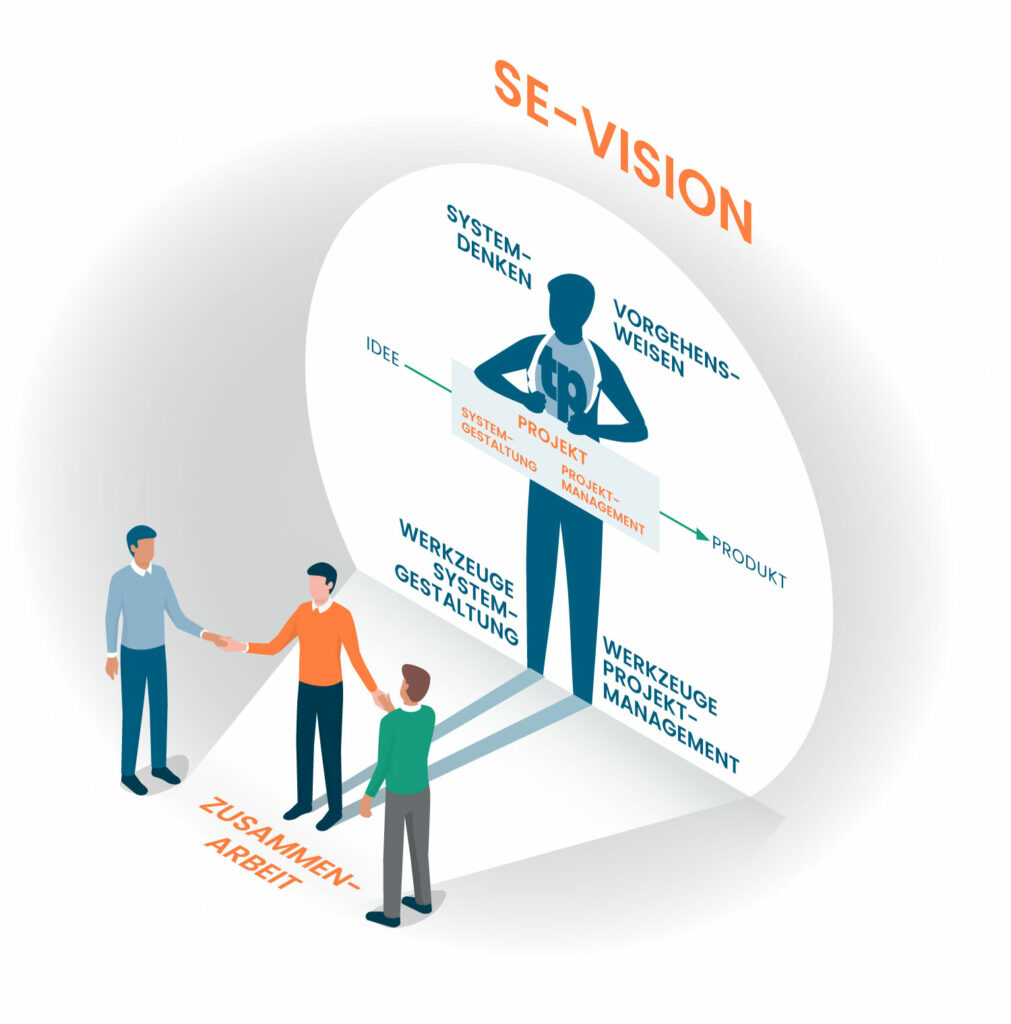Why Systems Engineering?
Nowadays, technical products integrate various disciplines such as mechanics, electronics and software very deeply. This brings growing challenges in product development with it: Increasing integration causes a large number of dependencies within a system to be developed – the system under design. What is needed here is a holistic method that takes into account all requirements in an interdisciplinary manner and helps to master the complexity: The development of such complex mechatronic systems is the goal of systems engineering.
At its core, it’s about:
- Improve communication and cooperation between those involved in development
- to achieve a uniform understanding of tasks and systems of all parties involved, and
- Recognizing and solving interdisciplinary development tasks
Model-Based Systems Engineering (MBSE) relies on the model-based description of the system for the implementation of these potential benefits and is thus a catalyst for more effectiveness and efficiency. The system model as the core of the MBSE describes requirements, functions and solution elements of the system to be developed. This information is available in a linked form and can be used, for example, for risk and impact analyses. Incomplete or confusing specifications therefore belong to the past.
Systems engineering is the method that accelerates your product development, iQUAVIS is the tool with which you can optimally implement this method.
Do you know what other companies think?
and MBSE
Top Management Theme
*of the companies surveyed, study: Systems Engineering in Germany. A comparison of the German entrepreneurial landscape. 2021.
What is Systems Engineering?
The most widely used definition of systems engineering comes from INCOSE – the International Council on Systems Engineering.
For systems engineers worldwide, INCOSE is what e.g. The VDI in Germany for engineers is:
“An interdisciplinary approach and a means to enable the realization of successful systems. The approach aims to define customer needs and the necessary functionality early in the development process, document the requirements and then proceed with the system design and coordination with the customer, taking into account the problem in its entirety. Systems Engineering considers both the economic and technical needs of the customer, with the aim of creating a high-quality product that meets the needs of the users.” (INCOSE)
This very technical definition is the common denominator of the professional world. In addition, the approach of Professor Reinhard Haberfellner, who describes systems engineering as a socio-technical approach, has also prevailed in the core community in Europe. He summarizes this approach in the Systems Engineering buddy, which also contributed significantly to the founding of Two Pillars .
Systems Engineering Buddy
Solve complex socio-technical issues now!
In addition to methods and tools, Haberfellner’s approach increasingly focuses on basic normative principles as well as initial approaches to change management. The well-known SE buddy is therefore divided into 3 areas:
1. The Systems Engineering journey begins in the mind.
The SE philosophy is divided into systems thinking and the most important procedures in systems engineering.
2. The feet give a firm footing in the SE application.
This is where the tools of system design and project management are anchored.
3. The fuselage is the connecting element.
Through the interaction of head and feet, the project is run through in a structured manner; this is where an idea is transformed into a solution or product. The head sets the direction, the feet carry the goal – and in the middle is the development process.

The History of Systems Engineering
Systems engineering established itself in the 20th century as a method for developing and managing complex systems. The particular strength lies in the holistic view of systems and their interactions in order to meet the specific requirements. However, with the increasing complexity of modern systems, the demands on systems engineering have also expanded. As a result, a new method has emerged that effectively addresses these challenges: Model-Based Systems Engineering (MBSE).
A major reason for this change is the need to meet the increasing demands for system complexity. MBSE makes it possible to model and analyze complex systems at a more abstract level, resulting in improved system understanding and mastery. By using models – keyword: digital twin – engineers can look at different aspects of a system simultaneously and assess the effects of changes better.
Another reason for the transition to MBSE is the increasing interdisciplinarity in system development. Modern systems require the cooperation of different disciplines such as mechanics, electronics, software and more. Through the use of models, these disciplines can develop and integrate their system components independently of each other. The models serve as a common language and interface to ensure a smooth flow of information and efficient collaboration – throughout the entire life cycle!
Systems engineering is not an invention of the 21st century. But what are exciting milestones?
FAQ Systems Engineering
Do you have any further questions about systems engineering? We have summarized common questions as well as typical problems with the introduction of MBSE in an FAQ for you. If you have any further questions, please do not hesitate to contact us personally.
